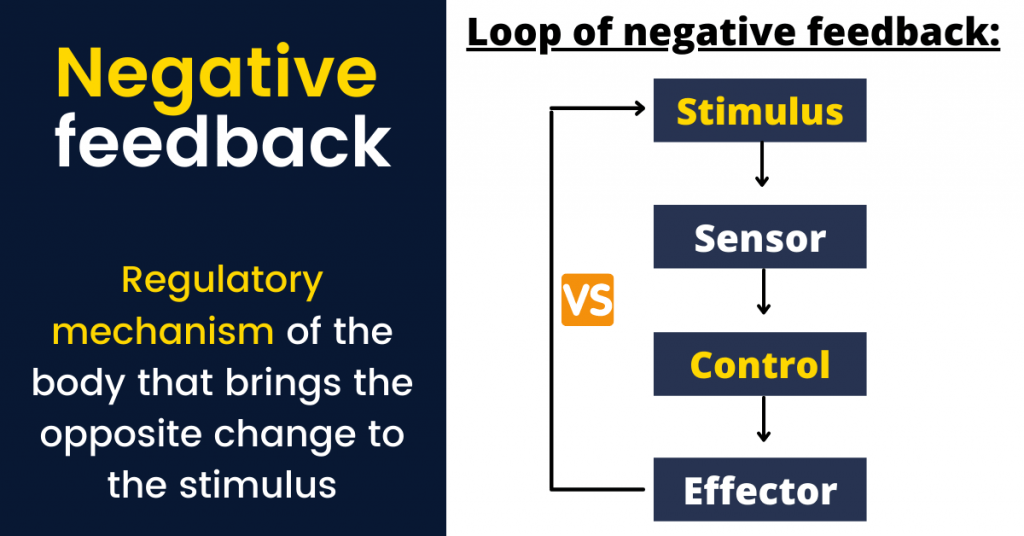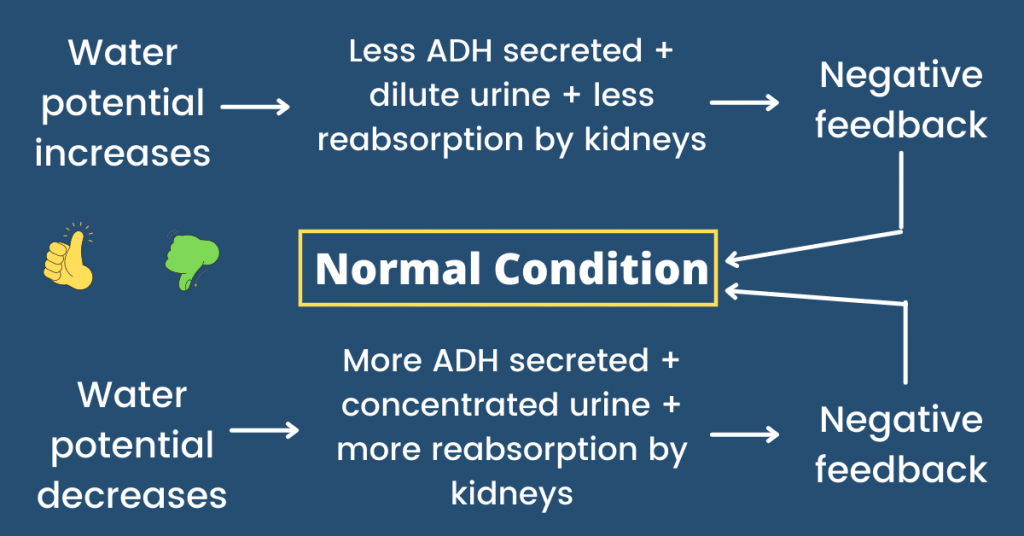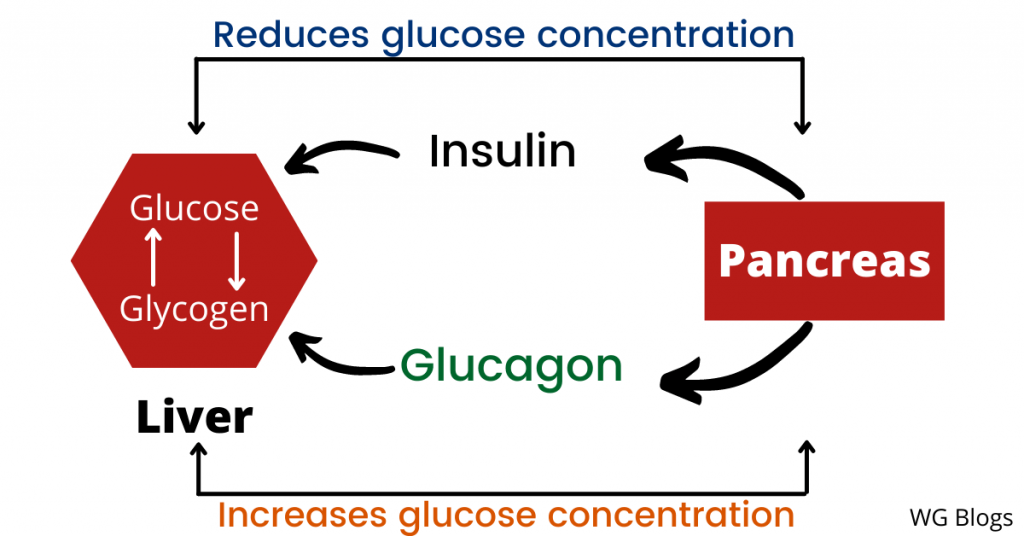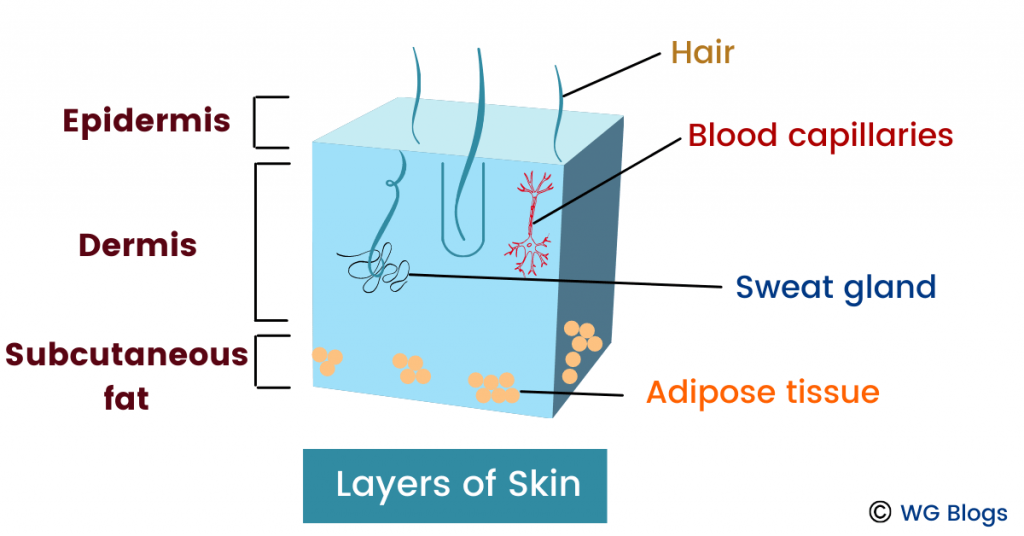The phenomenon of maintaining a relatively stable and constant internal environment by a biological system is known as homeostasis.
This system ensures that the organisms survive due to optimal functioning of the body by ensuring that the internal physical and chemical conditions are maintained.
When the body ensures stability at different levels (levels refers to different factors such as the ion concentration in the blood and temperature), the living organism as a whole survives by reaches stability (balanced environment).
Now you might be wondering, how does our body maintain normal conditions? In what circumstances does our body apply this concept? We will discuss all these concepts. So, let’s discuss these important topics without further introductions.
What is negative feedback?
Negative feedback is also known as balancing feedback and as the name suggests, this is the regulatory mechanism of the body.
This means that this biological process is responsible to counter any change or fluctuation in the body (ensuring that the conditions are normal).

Note: You should know that “stimulus” is the biological term which we use to refer to any change in the body.
Negative feedback is a vast term and is also applicable, apart from biological processes (such as maintaining atmospheric balance). But, we will only discuss this topic from the only biological point of view.
The regulation of body temperature, water potential and blood glucose level are some examples. Here, negative feedback plays a vital role because it is the mechanism of homeostasis. But, how does this happen? Let me show you how this happens step-by-step.
- Firstly, a stimulus (change) is detected by the receptor (a structure that responds to the stimuli).
- Then, the message is transferred to the brain and spinal cord through nerve impulses.
- As a result, an effector (muscle or organ that responds to the stimulus) is activated which does the complete opposite to the change (for example, if water potential was lowered, it will increase the water potential).
Now, let’s take a look at some examples as well.
Examples of homeostasis:
Osmoregulation (regulation of water potential):
Osmoregulation is the maintenance of water and salt content in the blood. It is also known as osmotic balance.
In the chapter about transport in mammals, we discussed that blood is made up of plasma (which consists of water), red blood cells, white blood cells and platelets. Therefore, it is important for the body to maintain the water and salt content to ensure survival.
Without this system, excess water and toxic waste materials can accumulate (increase) inside the human body that can prove to be fatal.
Our body takes different actions, depending upon the water potential.
When the water content in the blood increases from normal, our body takes the following actions.

- More water is excreted through urine to reduce the water content from the blood.
- The urine becomes relatively diluted due to the presence of more water.
- Less Antidiuretic hormone (ADH) is released.
This is because ADH controls the amount of water passed out through urine. For example, if less ADH is secreted, more water will pass out through urine (because ADH causes less water to be released from the body).
ADH is also known as vasopressin. It is made by the hypothalamus in the brain and is stored in the pituitary gland (secretes hormones into the bloodstream). Basically, it tells the kidneys about how much water should be excreted.
All these actions are the example of negative feedback that cause the water potential in the blood to return back to normal.
Further reading:
Excretion explained in plain English | GCE O Level Biology
Best Respiration Notes | Biology (5090)
When the water content in the blood reduces from normal, the body takes the following actions:
- Less water is excreted through the urine because water has to be retained by the body.
- Urine becomes relatively concentrated (due to less water and more salt and other content).
- More ADH (vasopressin) is released to absorb more water by the kidneys (so that less water is excreted).
These opposite changes to the stimulus (change), causes the body condition to return back to normal.
Quick question: From the information above, did you find out where the Antidiuretic hormone is produced and where it is stored?
This takes us to another example which is about the maintenance of the glucose level in our body.
Regulation of blood glucose level:
It is important to maintain our glucose level because it is responsible for carrying out vital activities of the body. Without this, one can suffer long term problems such as heart diseases, kidney diseases and loss of vision.
Our body takes different actions depending on the level of glucose in our body.

When the glucose concentration in our blood increases from normal (for example, after a meal), our body takes the following action to normalise the conditions:
- The pancreas secretes insulin (hormone to decrease the glucose concentration).
Insulin helps your body to store glucose in the liver, muscles and fat. But, how does this happen? Let me tell you all this, step-by-step.
- Firstly, you consume a meal (rich in carbohydrates).
- When carbohydrates enter your body, they undergo digestion which converts them to glucose.
- This glucose is used by the body to carry out its functions. But, there is some extra glucose as well which your body does not currently need.
- So, insulin converts this glucose into glycogen (insoluble in nature and compact in shape and size) which is then stored in the liver.
Note: Glucose is stored as glycogen because it is compact in shape. So, it does not consume a lot of space. Moreover, it is insoluble in nature. So, it does not change the water potential of the blood.
But, when the glucose concentration in our body decreases from normal, our body releases the hormone – Glucagon.
Glucagon increases the blood glucose concentration by converting the stored glycogen (in the liver) to glucose. In simple words, glucagon prevents blood glucose concentration from becoming to low.
The step-by-step process is:
- After a heavy exercise, the blood glucose concentration in your body drops. As a result, your body requires more glucose for energy.
- As a result, the pancreas secretes the hormone, glucagon, which enters the bloodstream.
- In the Liver, glucagon converts the stored glycogen to glucose to be used by the body.
This is how our body maintains the level of glucose with the help of balancing (negative) feedback. This takes us to another very important topic which is diabetes. So, let’s discuss that as well.
Diabetes:
This is the condition when the glucose concentration remains very high in your body. This is because there is no insulin secreted to regulate the glucose level (by converting excess glucose to glycogen).
As a result, you may have increased hunger, thirst, fatigue, blurry vision and even weight loss in some cases. In type 1 diabetes, your body’s immune system destroys the insulin-producing cells (in the pancreas).
Note: The indication of diabetes is the presence of glucose in the urine.
Since it is very important to maintain the glucose level, people suffering from diabetes take the following actions:
- Drugs to control the glucose level.
- Insulin is directly injected into the body (injections).
- Take a proper diet and constantly check the glucose level in the body.
To summarise, diabetes is a problem in which the body is unable to maintain the blood glucose level. The excess glucose is not reabsorbed by our body and is excreted through urine.
The people suffering from this disease have to regularly check their glucose concentration (by testing their urine regularly) and take diet accordingly. They may even inject insulin into their veins.
With this, it is time to move on another very important topic about thermoregulation.
Thermoregulation:
Thermoregulation is the homeostasis of the body temperature and this mechanism ensures a constant body temperature.
It is important to maintain body temperature to prevent heart diseases and brain damage. The human skin is designed in a manner that keeps the body temperature normal.
Our skin is the largest organ of our body and it allows us to sense hot and cold. It even protects us from harmful elements as well. But, how does our skin keeps the temperature constant? Before understanding this, let me take you through the structure of the human skin.

- Epidermis: It is the outermost (top) layer of the skin. It makes our skin tone and is the part that is visible to us.
The epidermis is also responsible for making new cells and protecting our body against germs. This layer is also water-resistant and contains dry and dead cells due to Keratin (a protective protein).
- Dermis: This layer is below (beneath) the epidermis. It contains hair follicles, sweat glands, connective tissues, sense receptors and blood vessels.
When it comes to the blood vessels, we have arteries that dilate (vasodilation) so that more blood is sent to the skin. On the other hand, when the arteries constrict (vasoconstriction), less blood is sent to the skin.
But, how does this ensure thermoregulation? We will see that in a while as well.
Hair follicles are found in the dermal layer of the skin and are responsible for hair growth. In simple words, hair grows inside the hair follicle which is connected to the hair erector muscles.
Then comes the sweat glands that play a vital role in thermoregulation. When the sweat is produced inside it, it flows out through the sweat duct. This allows us to release heat from our body and get rid of toxic materials (such as nitrogenous waste products) as well.
Apart, the sebaceous gland in the dermis produces oil which keeps the skin smooth and soft. This oily substance, sebum, prevent dehydration as well. Lastly, there are nerve endings in the dermis as well which allow our body to feel things.
This is done with the help of nerve impulses that are transmitted in case of a change. These nerve impulses travel to the central nervous system (brain and spinal cord).
- Subcutaneous fat:
This fat is visible under the skin and protects our body against some diseases. The connective tissues in the subcutaneous fat connect the dermis to the muscles and bones.
Similarly, the fat in these cells are responsible for insulating purposes (keeping the body warm) and prevents the body temperature from becoming too hot or cold.
Now, let’s discuss the actions taken by our body during a hot and a cold day.
What happens during a hot day (high temperature):
During a hot day, our body takes the following actions to release heat energy from the body:
- Vasodilation (more blood is sent to the skin which causes heat energy to be lost from the body).
- Sweating (sweat glands become more active).
- Hair erector muscles relax.
- Metabolic activities decrease because they produce heat energy.
- More heat is lost through rapid breathing, faeces and urine.
Due to all this, heat energy is lost from the body during hot days, which allows the body to stay cool.
What happens during a cold day (low temperature):
Remember that due to the colder climate, the body takes actions to minimize heat loss and retain the maximum heat. As a result, the body does the following:
- Vasoconstriction causes less blood to flow to the skin which prevents heat loss by conduction, convection and radiation.
- The sweat glands become less active. Therefore, less sweating causes less heat to be released.
- Hair erector muscles contract which makes the hairs “stand”. The hairs trap air which is a poor conductor of heat (so, heat is retained). Shivering also starts to keep the body warmer.
- Metabolic activities increase to produce more heat.
Now you might be wondering, how does the body know that the temperature has increased or fall? The answer to this is that whenever there is a stimulus (change), nerve impulses are generated, which transfer a message to the brain.
After this, the brain takes proper actions accordingly. It is important for our body to maintain a normal core temperature so that our enzymes work properly, the body stays active and we do not have to hibernate.
Practise questions:
Now, it is time for you to practise some questions as well.
Question 1:
What happens when the core body temperature increases from normal?
| arterioles near skin surface | sweat secreted | |
| A. | constricted | No |
| B. | constricted | Yes |
| C. | dilated | No |
| D. | dilated | Yes |
The answer to this question is D. This is because when arterioles will dilate, more heat energy will be lost from the body (which will cool the body down). You should also know that heat will be also lost through sweating as well.
Question 2:
Which of these statements are correct for the term, negative feedback?
- Platelets are activated in the blood after an injury, and these activated platelets release chemicals that activate more platelets.
- When blood pressure is high, the nerve impulses cause the blood vessels to dilate, and blood pressure is reduced.
- When the glucose level in the blood decreases, the hormone glucagon converts the stored glycogen to glucose, which increases the blood glucose concentration.
A. 1 and 2
B. 2 and 3
C. 1 only
D. 3 only
The correct answer is B. This is because both the second and third statements show that the body takes opposite actions to a change. This balances the change, which is known as balancing (negative) feedback.
Conclusion:
With this, the article about homeostasis has come to an end. I hope that all your queries have been answered and all the mportant concepts have been cleared.
You should practise plenty of past paper questions regarding this topic because it is very important from an examination point of view. Some of the topics covered in this article are osmoregulation, regulation of blood glucose concentration, diabetes and thermoregulation.
Thank you very much for reading and staying with me till the end. Stay tuned for more.
